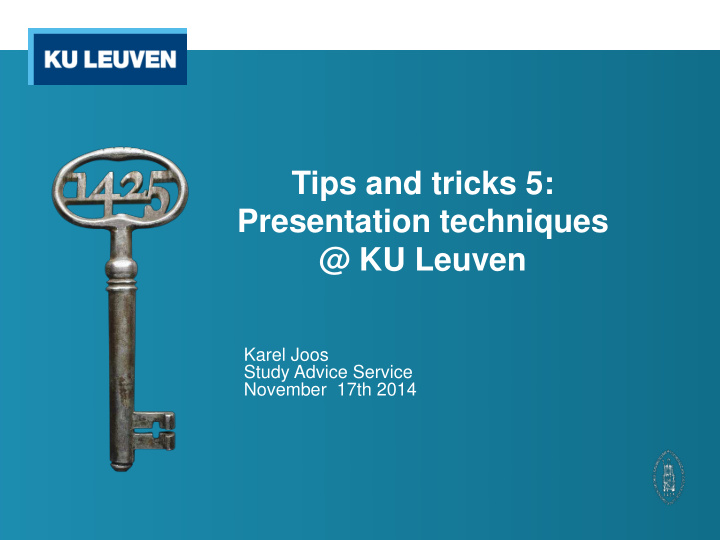



Tips and tricks 5: Presentation techniques @ KU Leuven Karel Joos Study Advice Service November 17th 2014
Overview • Introduction • General Language o Body language o • Content • Support material • Stress • Exercice
Introduction • Example : what do you want to change in this presentation? • Overview of relevant topics o Suggestions to practice (exaggerate in opposite direction)
Language • Tempo o Tempo of talking : better to slow than to fast • Talk extremely slow • Every syllable apart • One syllable per second o Tempo of presentation • Pause between sentences • Change tempo (important = slow) • Articulation o Talk with your teeth one on another
Language (2) • Loudness o Talk very loud • Intonation o Try to tell a stiff story for a child • Build up tension o Important vs unimportant o Approval vs disapproval
Language (3) • Goal o Your public needs to understand at least what you are saying • Problems?? o You are not convinced yourself about what you are saying? o …
Body language • Posture o On two legs • What happens if you talk on the tip of one foot • Mimic o Smiling, eyebrows, … o Important vs unimportant o Yes vs no • Talk to yourself in a mirror
Body language (2) • Eye contact o Skip from one listener to another, make eye contact for 1’’ • Gestures o Illustrate with your hands what you are saying o Basic position? • Spontanuous, enthousiastic o Talk like explaining to a friend
Body language (3) • Goal : o As human being with a story o Not as robot • Problems : o It is only the content that counts.
Content 1. Clear structure Telling what your are going to tell o Table of contents o • Return regularly to the table of contents Consider your audience as outsiders!! o Intermediate conclusions o 2. Key words You can’t read a full text Key words on cards (or on ppt) Reconstruct
Content (2) 3. Addressing to public I – you 4. Short sentences One subject, one verb, … 5. Simple words No slang 6. Examples, anecdotes Attractive, keeps people attentive o
Content (3) 7. Personal point of view Argumented point of view : “because”, “but I think” • Indicate what’s in the article, what’s your idea • 8. Conclusion at the end Summary • Most important aspects • “are there any questions?” •
Content (4) • Goal : o Bringing to life • Problems o “People already know what I will tell!”
Support material • Sometimes it can be useful to support your presentation with different kinds of support material, such as ppt, slides, … or eventually an other way of support on which we didn’t think at this moment It is very important to keep in mind that it’s always better not to use to many text in this sort of support. o The more text there is on a slide, the more difficult it will be for the audience to grasp the heart of the matter of your presentation. Better is : o
Stress • Relax (first fysically, than mentally?) • Self-confidence • Focus on audience, not on yourself • Practice before mirror • Practicing in the room (or imagine room) • Smile • Good preparation (keywords, cards) • Record yourself • …
Try out • Prepare short presentation (2’) o Keywords • Presentation for other student o Standing • Feedback • Changing role
Contact o Study Advice Service Naamsestraat 80 3000 Leuven 016/32 43 11 www.kuleuven.be/studyadvice o Karel.Joos@dsv.kuleuven.be
Succes
Recommend
More recommend